How to get your first 1,000 followers on LinkedIn (7 easy steps)




Ever heard of the phrase “The first million is the hardest”?
Well, with LinkedIn, the same applies to follower growth. On a smaller scale, of course.
Between creating valuable content, building audience trust and carefully expanding your network, building a loyal follower base on the platform can take a lot of time and effort.
Unfortunately, this can also translate into a ton of procrastination. Don’t worry - we’ve all been there.
If you’re looking to jumpstart follower growth, follow our 7-step checklist below to build your first 1000 LinkedIn followers.
1. Be intentional about your audience
The first question that you should ask yourself before you get started is: What do I want to get out of LinkedIn?
Do you want to be known as an expert so that you can get hired?
Are you an industry leader that wants to share knowledge?
Are you selling a product or service? Do you want to find new clients?
If you know what you want out of the platform you can be intentional about who your audience is. Once you become intentional about your audience, you can tailor your content towards them.
To paraphrase Andrew Gazdecki’s post and relate it to audience building: Find your 10 loyal followers, know what works for them and why, and you are all set for growth.
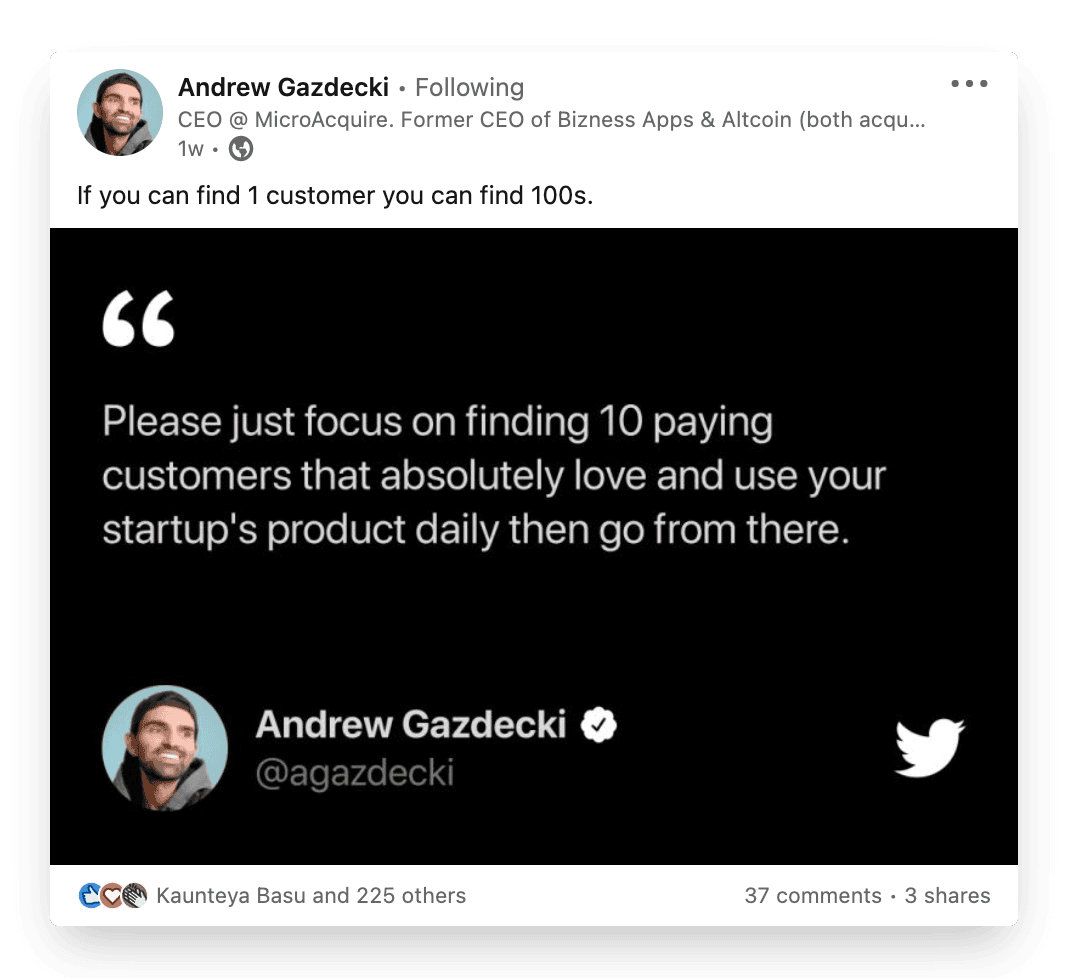
2. Block your calendar for LinkedIn
Put LinkedIn on the calendar.
If you want to build follower growth in a relatively short time frame, you’ll need to be active on LinkedIn. A lot. To build the habit of spending the right amount of time on the platform, it's important you are mindful of what you use that time for.
On a weekly basis, you should be:
Allocating time to plan out content.
Viewing analytics with a LinkedIn analytics tool to track content performance..
Creating daily calendar reminders for engagement.
On a daily basis, you should be:
Browsing your LinkedIn feed.
Sending out connection requests.
Responding to comments on your posts, as well as interacting with other posts.
To make this process even more streamlined, you can turn notifications on for different LinkedIn creators, so that you’re notified whenever they post! Just click the bell icon at the top of the profile page.
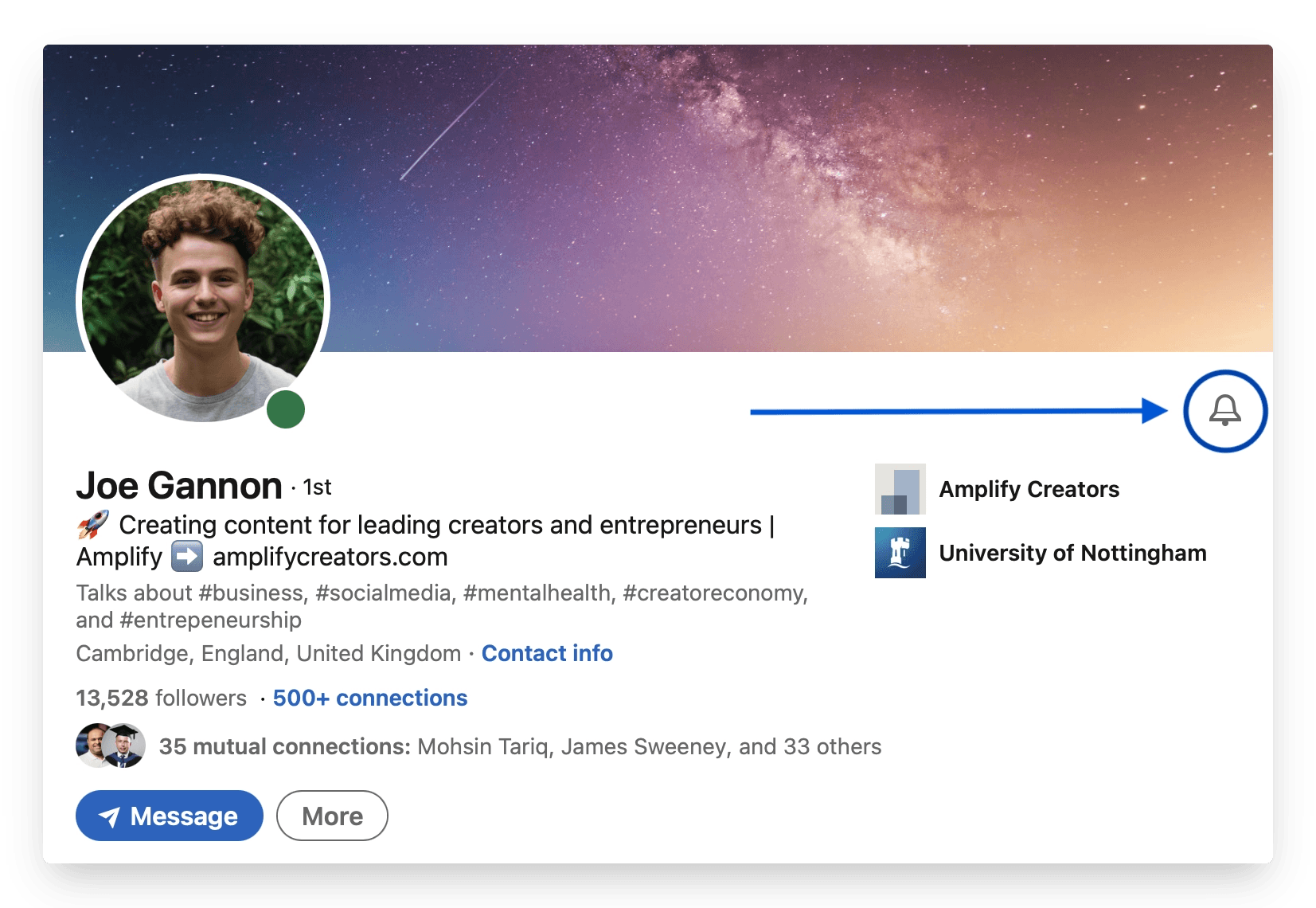
If you struggle to keep up-to-date with the above, it can’t hurt to get an accountability buddy either!
3. Keep your LinkedIn Profile updated
Whether someone is seeing your content in their feed for the first time, or whether they’re receiving a connection request from you, there is always one guarantee: they’re going to head straight to your profile.
It’s your job to make sure that your LinkedIn profile paints the right picture about who you are, what you do, and what you’ve achieved.
Simmy Dhillon’s page is a great example of this in practice. Let’s break down why:
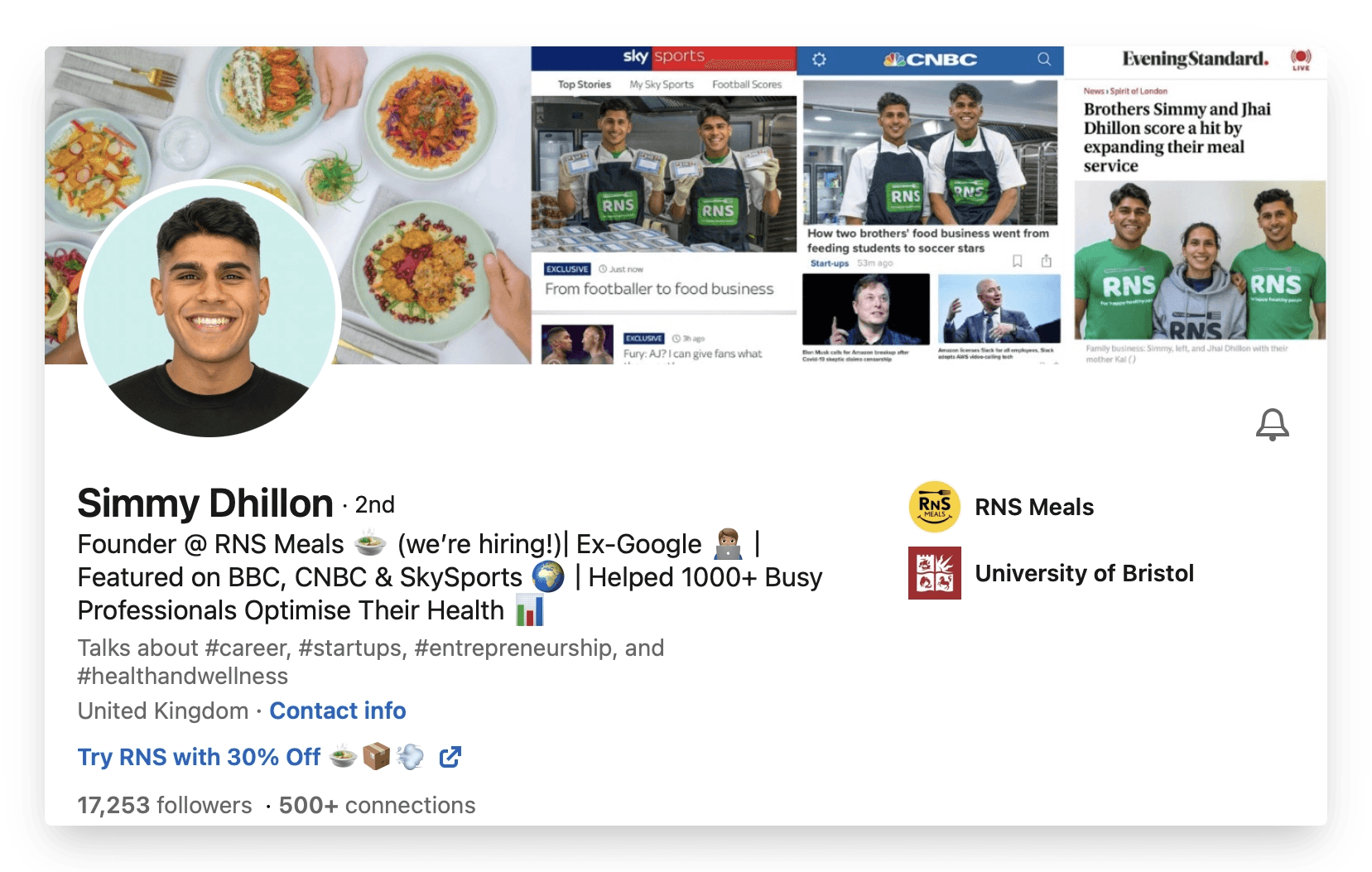
Here’s a few things that Simmy is doing right:
His profile picture is high-quality, clear, and without an overcrowded background. And yes, there’s no harm in smiling either!
His header image showcases what his company RNS Meals does as well as some of their accolades. If your company has distinctive brand colours, you could factor them into your header too.
Simmy’s headline gives us a better idea of who he is, where he works and what he’s achieved. Don’t be afraid to use emojis. The more memorable your headline, the better.
Scrolling down Simmy’s page, pay attention to his ‘About’ and ‘Featured Sections’ too which summarise what he does and showcases some of his posts on LinkedIn.
Want an ultimate guide on building an optimized LinkedIn profile? Check out our blog post here.
4. Find the right people to follow
After you’ve built out your profile page, it’s time to follow the right accounts.
You could start searching relevant creators and industry keywords into the LinkedIn search bar and work from there.
You could also:
Follow mutual 2nd-degree connections. They’re much more likely to accept than cold connections.
Follow people in similar roles or with similar interests.
Discover new accounts through content you like and engage with. If you’re already enjoying and engaging with their content, they’ll undoubtedly make a great addition to your network.
5. Create Content
Of course, there’s one thing every LinkedIn creator should schedule time for in their calendar.
Content creation.
Quick tip: Using an employer advocacy software can also help amplify your posts, as colleagues engage and share your content.
The themes you write about depend entirely on your desired output as a creator. If you’re stuck for ideas, it can’t hurt to ask yourself:
What am I good at?
What experiences have I had that could benefit others?
Who am I writing for?
Here’s a great post from Holly Crashaw that covers the above.
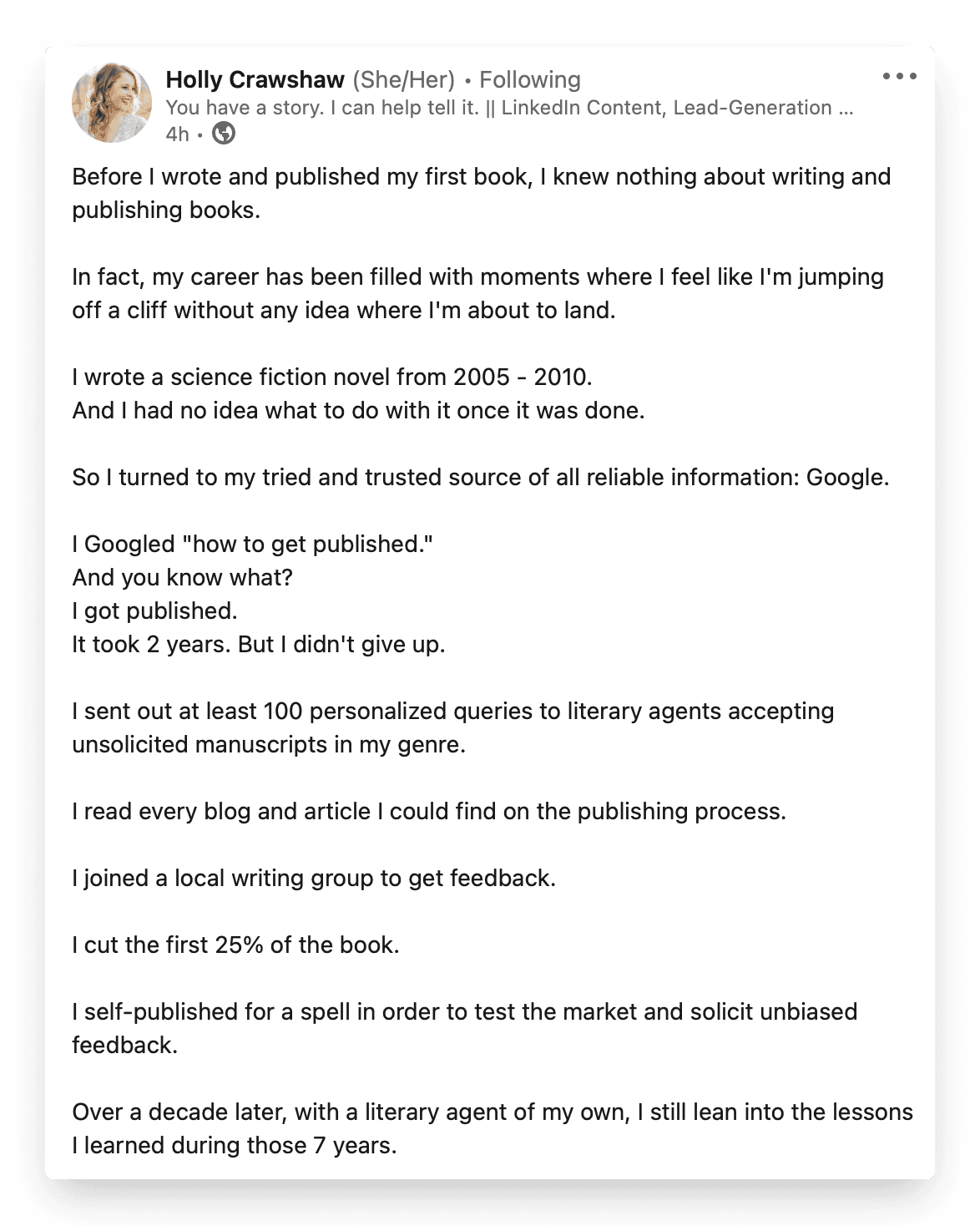
Holly’s in the unique position of having published her first book. As such, she’s got plenty of knowledge and experiences that she can leverage in her content.
Here’s what Holly is doing right:
Her opening line highlights her know-how as an author. Great: this is her hook.
Her post structure is spaced out so it’s easy to read, particularly on mobile.
The main body of her text delivers on its value promise.
For a more in-depth look at how to write a great LinkedIn post, check out our blog here.
BONUS: Using SHIELD to repurpose content:
If you want to post on LinkedIn multiple times per week, it’s a good idea to start with your best-performing content.
With the click of a few buttons in SHIELD, you can view high-performing content and then easily repurpose it.
All you have to do is:
Open your ‘SHIELD’ account.
Press ‘Content Overview’ to view all content.
Adjust the dates to show content that dates back to 3+ months ago.
Pick a post that performed well, and copy and paste the copy onto LinkedIn.
Make small tweaks to the copy, and press ‘Post’.
Bonus+: Repurposing high-performing content can be particularly effective in a corporate influencer program, allowing employees to build their personal brands while boosting company visibility.
6. Build your engagement and commenting strategy
LinkedIn isn’t a one-way street; you can’t post and ghost.
You need to take the time to build rapport and engage with your community. As you might expect, this starts with the comments section.
But before we get into what makes a good comment, let’s list a couple of our pet peeves when it comes to post-engagement:
Posting emojis without any text.
Posting generic responses such as ‘Thank you’ and ‘I agree’.
Comments like these don’t add meaningfully to a post’s internal chatter, and will likely not receive any engagement as a result.
On the other side, here’s an example of an active comments section.
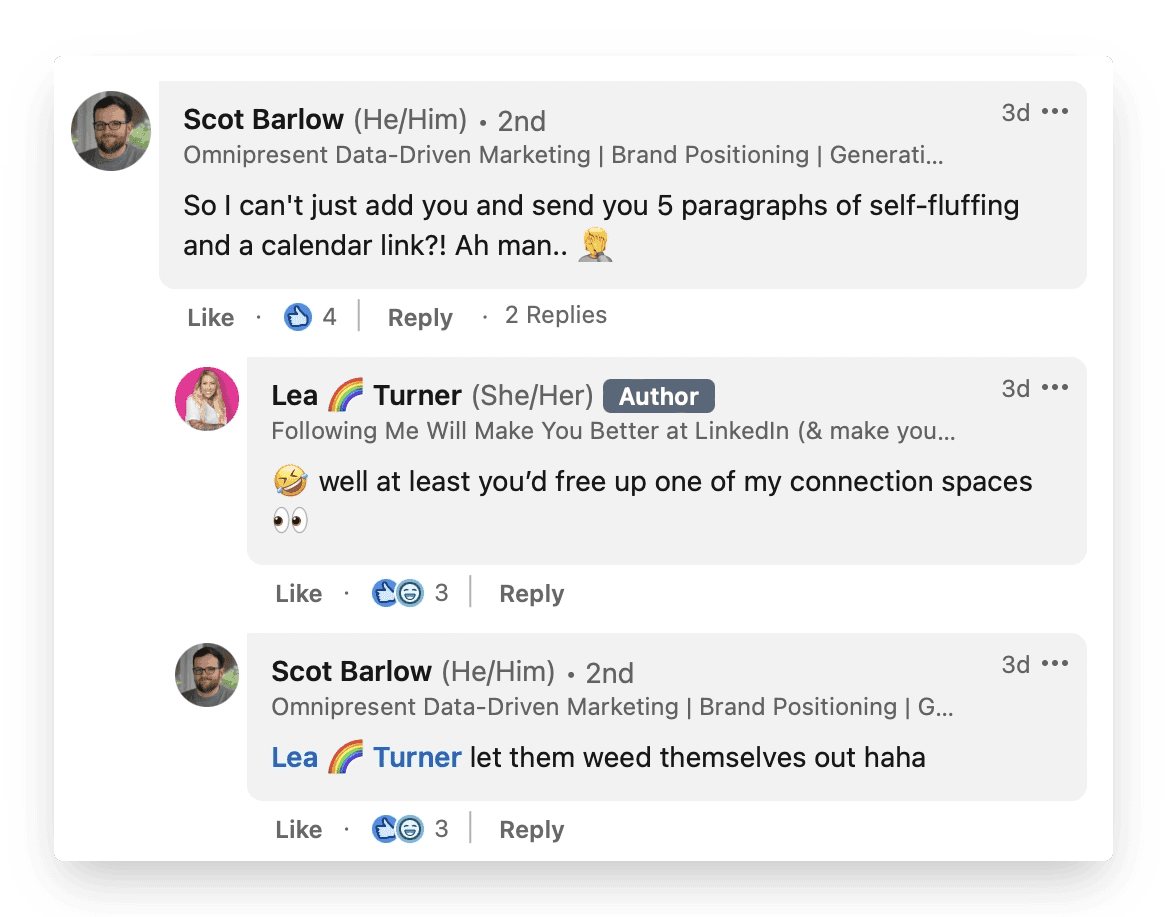
Lea responds to Scot’s comment because, you guessed it, he actively engages with the topic at hand, adding his own opinions about the post’s core message.
That’s right, comment sections shouldn’t be places for generic messaging. You should feel confident to add your own ideas and agree or disagree with the post’s ideas.
After all, the more responses you generate, the more your comments will appear in other people’s feeds.
7. Focus on the outbound
Another way to build your growth is by focusing on your outbound efforts, starting with sending connection requests. Making each request count is especially important as free LinkedIn accounts have a 20 connection limit per day on average.
Please note that: A social selling software can streamline your outbound efforts, making it easier to connect with potential clients through LinkedIn.
Let’s get a few of our don’ts out of the way before we focus on what makes a good connection request:
Don’t send bare-bones connection requests without a message.
Some accounts receive hundreds of requests weekly. If you’re not making the effort with an outbound message, why should they pay attention to yours?
Don’t pitch in your message.
People hate being sold to, so don’t bombard potential connections with facts about what you can offer them. This is a one-way ticket to the ‘Decline’ button.
Now, for a good connection request:
Make it personalized
Doing your homework pays dividends here. Instead of entering cold, or talking about yourself, tell them why you want to connect. Perhaps their posts particularly resonate with you, or perhaps you’re interested in their career path. Whatever it is, be sure to mention it in your message.
Add a mutual connection
If you’re connecting with someone who is a mutual connection, be sure to add a call-back. It’ll, at the very least, make them more likely to accept your request.
For more tips check out our article for connecting with other like-minded creators.
The above steps will get you to your first 1000 followers and beyond, but only if you’re consistent. Before you click away from this blog, book time into your calendar and make networking and content creation part of your daily routine!
The rest is a piece of cake.
Joe Gannon x Pragya
Ever heard of the phrase “The first million is the hardest”?
Well, with LinkedIn, the same applies to follower growth. On a smaller scale, of course.
Between creating valuable content, building audience trust and carefully expanding your network, building a loyal follower base on the platform can take a lot of time and effort.
Unfortunately, this can also translate into a ton of procrastination. Don’t worry - we’ve all been there.
If you’re looking to jumpstart follower growth, follow our 7-step checklist below to build your first 1000 LinkedIn followers.
1. Be intentional about your audience
The first question that you should ask yourself before you get started is: What do I want to get out of LinkedIn?
Do you want to be known as an expert so that you can get hired?
Are you an industry leader that wants to share knowledge?
Are you selling a product or service? Do you want to find new clients?
If you know what you want out of the platform you can be intentional about who your audience is. Once you become intentional about your audience, you can tailor your content towards them.
To paraphrase Andrew Gazdecki’s post and relate it to audience building: Find your 10 loyal followers, know what works for them and why, and you are all set for growth.

2. Block your calendar for LinkedIn
Put LinkedIn on the calendar.
If you want to build follower growth in a relatively short time frame, you’ll need to be active on LinkedIn. A lot. To build the habit of spending the right amount of time on the platform, it's important you are mindful of what you use that time for.
On a weekly basis, you should be:
Allocating time to plan out content.
Viewing analytics with a LinkedIn analytics tool to track content performance..
Creating daily calendar reminders for engagement.
On a daily basis, you should be:
Browsing your LinkedIn feed.
Sending out connection requests.
Responding to comments on your posts, as well as interacting with other posts.
To make this process even more streamlined, you can turn notifications on for different LinkedIn creators, so that you’re notified whenever they post! Just click the bell icon at the top of the profile page.

If you struggle to keep up-to-date with the above, it can’t hurt to get an accountability buddy either!
3. Keep your LinkedIn Profile updated
Whether someone is seeing your content in their feed for the first time, or whether they’re receiving a connection request from you, there is always one guarantee: they’re going to head straight to your profile.
It’s your job to make sure that your LinkedIn profile paints the right picture about who you are, what you do, and what you’ve achieved.
Simmy Dhillon’s page is a great example of this in practice. Let’s break down why:

Here’s a few things that Simmy is doing right:
His profile picture is high-quality, clear, and without an overcrowded background. And yes, there’s no harm in smiling either!
His header image showcases what his company RNS Meals does as well as some of their accolades. If your company has distinctive brand colours, you could factor them into your header too.
Simmy’s headline gives us a better idea of who he is, where he works and what he’s achieved. Don’t be afraid to use emojis. The more memorable your headline, the better.
Scrolling down Simmy’s page, pay attention to his ‘About’ and ‘Featured Sections’ too which summarise what he does and showcases some of his posts on LinkedIn.
Want an ultimate guide on building an optimized LinkedIn profile? Check out our blog post here.
4. Find the right people to follow
After you’ve built out your profile page, it’s time to follow the right accounts.
You could start searching relevant creators and industry keywords into the LinkedIn search bar and work from there.
You could also:
Follow mutual 2nd-degree connections. They’re much more likely to accept than cold connections.
Follow people in similar roles or with similar interests.
Discover new accounts through content you like and engage with. If you’re already enjoying and engaging with their content, they’ll undoubtedly make a great addition to your network.
5. Create Content
Of course, there’s one thing every LinkedIn creator should schedule time for in their calendar.
Content creation.
Quick tip: Using an employer advocacy software can also help amplify your posts, as colleagues engage and share your content.
The themes you write about depend entirely on your desired output as a creator. If you’re stuck for ideas, it can’t hurt to ask yourself:
What am I good at?
What experiences have I had that could benefit others?
Who am I writing for?
Here’s a great post from Holly Crashaw that covers the above.

Holly’s in the unique position of having published her first book. As such, she’s got plenty of knowledge and experiences that she can leverage in her content.
Here’s what Holly is doing right:
Her opening line highlights her know-how as an author. Great: this is her hook.
Her post structure is spaced out so it’s easy to read, particularly on mobile.
The main body of her text delivers on its value promise.
For a more in-depth look at how to write a great LinkedIn post, check out our blog here.
BONUS: Using SHIELD to repurpose content:
If you want to post on LinkedIn multiple times per week, it’s a good idea to start with your best-performing content.
With the click of a few buttons in SHIELD, you can view high-performing content and then easily repurpose it.
All you have to do is:
Open your ‘SHIELD’ account.
Press ‘Content Overview’ to view all content.
Adjust the dates to show content that dates back to 3+ months ago.
Pick a post that performed well, and copy and paste the copy onto LinkedIn.
Make small tweaks to the copy, and press ‘Post’.
Bonus+: Repurposing high-performing content can be particularly effective in a corporate influencer program, allowing employees to build their personal brands while boosting company visibility.
6. Build your engagement and commenting strategy
LinkedIn isn’t a one-way street; you can’t post and ghost.
You need to take the time to build rapport and engage with your community. As you might expect, this starts with the comments section.
But before we get into what makes a good comment, let’s list a couple of our pet peeves when it comes to post-engagement:
Posting emojis without any text.
Posting generic responses such as ‘Thank you’ and ‘I agree’.
Comments like these don’t add meaningfully to a post’s internal chatter, and will likely not receive any engagement as a result.
On the other side, here’s an example of an active comments section.

Lea responds to Scot’s comment because, you guessed it, he actively engages with the topic at hand, adding his own opinions about the post’s core message.
That’s right, comment sections shouldn’t be places for generic messaging. You should feel confident to add your own ideas and agree or disagree with the post’s ideas.
After all, the more responses you generate, the more your comments will appear in other people’s feeds.
7. Focus on the outbound
Another way to build your growth is by focusing on your outbound efforts, starting with sending connection requests. Making each request count is especially important as free LinkedIn accounts have a 20 connection limit per day on average.
Please note that: A social selling software can streamline your outbound efforts, making it easier to connect with potential clients through LinkedIn.
Let’s get a few of our don’ts out of the way before we focus on what makes a good connection request:
Don’t send bare-bones connection requests without a message.
Some accounts receive hundreds of requests weekly. If you’re not making the effort with an outbound message, why should they pay attention to yours?
Don’t pitch in your message.
People hate being sold to, so don’t bombard potential connections with facts about what you can offer them. This is a one-way ticket to the ‘Decline’ button.
Now, for a good connection request:
Make it personalized
Doing your homework pays dividends here. Instead of entering cold, or talking about yourself, tell them why you want to connect. Perhaps their posts particularly resonate with you, or perhaps you’re interested in their career path. Whatever it is, be sure to mention it in your message.
Add a mutual connection
If you’re connecting with someone who is a mutual connection, be sure to add a call-back. It’ll, at the very least, make them more likely to accept your request.
For more tips check out our article for connecting with other like-minded creators.
The above steps will get you to your first 1000 followers and beyond, but only if you’re consistent. Before you click away from this blog, book time into your calendar and make networking and content creation part of your daily routine!
The rest is a piece of cake.
Joe Gannon x Pragya
Ever heard of the phrase “The first million is the hardest”?
Well, with LinkedIn, the same applies to follower growth. On a smaller scale, of course.
Between creating valuable content, building audience trust and carefully expanding your network, building a loyal follower base on the platform can take a lot of time and effort.
Unfortunately, this can also translate into a ton of procrastination. Don’t worry - we’ve all been there.
If you’re looking to jumpstart follower growth, follow our 7-step checklist below to build your first 1000 LinkedIn followers.
1. Be intentional about your audience
The first question that you should ask yourself before you get started is: What do I want to get out of LinkedIn?
Do you want to be known as an expert so that you can get hired?
Are you an industry leader that wants to share knowledge?
Are you selling a product or service? Do you want to find new clients?
If you know what you want out of the platform you can be intentional about who your audience is. Once you become intentional about your audience, you can tailor your content towards them.
To paraphrase Andrew Gazdecki’s post and relate it to audience building: Find your 10 loyal followers, know what works for them and why, and you are all set for growth.

2. Block your calendar for LinkedIn
Put LinkedIn on the calendar.
If you want to build follower growth in a relatively short time frame, you’ll need to be active on LinkedIn. A lot. To build the habit of spending the right amount of time on the platform, it's important you are mindful of what you use that time for.
On a weekly basis, you should be:
Allocating time to plan out content.
Viewing analytics with a LinkedIn analytics tool to track content performance..
Creating daily calendar reminders for engagement.
On a daily basis, you should be:
Browsing your LinkedIn feed.
Sending out connection requests.
Responding to comments on your posts, as well as interacting with other posts.
To make this process even more streamlined, you can turn notifications on for different LinkedIn creators, so that you’re notified whenever they post! Just click the bell icon at the top of the profile page.

If you struggle to keep up-to-date with the above, it can’t hurt to get an accountability buddy either!
3. Keep your LinkedIn Profile updated
Whether someone is seeing your content in their feed for the first time, or whether they’re receiving a connection request from you, there is always one guarantee: they’re going to head straight to your profile.
It’s your job to make sure that your LinkedIn profile paints the right picture about who you are, what you do, and what you’ve achieved.
Simmy Dhillon’s page is a great example of this in practice. Let’s break down why:

Here’s a few things that Simmy is doing right:
His profile picture is high-quality, clear, and without an overcrowded background. And yes, there’s no harm in smiling either!
His header image showcases what his company RNS Meals does as well as some of their accolades. If your company has distinctive brand colours, you could factor them into your header too.
Simmy’s headline gives us a better idea of who he is, where he works and what he’s achieved. Don’t be afraid to use emojis. The more memorable your headline, the better.
Scrolling down Simmy’s page, pay attention to his ‘About’ and ‘Featured Sections’ too which summarise what he does and showcases some of his posts on LinkedIn.
Want an ultimate guide on building an optimized LinkedIn profile? Check out our blog post here.
4. Find the right people to follow
After you’ve built out your profile page, it’s time to follow the right accounts.
You could start searching relevant creators and industry keywords into the LinkedIn search bar and work from there.
You could also:
Follow mutual 2nd-degree connections. They’re much more likely to accept than cold connections.
Follow people in similar roles or with similar interests.
Discover new accounts through content you like and engage with. If you’re already enjoying and engaging with their content, they’ll undoubtedly make a great addition to your network.
5. Create Content
Of course, there’s one thing every LinkedIn creator should schedule time for in their calendar.
Content creation.
Quick tip: Using an employer advocacy software can also help amplify your posts, as colleagues engage and share your content.
The themes you write about depend entirely on your desired output as a creator. If you’re stuck for ideas, it can’t hurt to ask yourself:
What am I good at?
What experiences have I had that could benefit others?
Who am I writing for?
Here’s a great post from Holly Crashaw that covers the above.

Holly’s in the unique position of having published her first book. As such, she’s got plenty of knowledge and experiences that she can leverage in her content.
Here’s what Holly is doing right:
Her opening line highlights her know-how as an author. Great: this is her hook.
Her post structure is spaced out so it’s easy to read, particularly on mobile.
The main body of her text delivers on its value promise.
For a more in-depth look at how to write a great LinkedIn post, check out our blog here.
BONUS: Using SHIELD to repurpose content:
If you want to post on LinkedIn multiple times per week, it’s a good idea to start with your best-performing content.
With the click of a few buttons in SHIELD, you can view high-performing content and then easily repurpose it.
All you have to do is:
Open your ‘SHIELD’ account.
Press ‘Content Overview’ to view all content.
Adjust the dates to show content that dates back to 3+ months ago.
Pick a post that performed well, and copy and paste the copy onto LinkedIn.
Make small tweaks to the copy, and press ‘Post’.
Bonus+: Repurposing high-performing content can be particularly effective in a corporate influencer program, allowing employees to build their personal brands while boosting company visibility.
6. Build your engagement and commenting strategy
LinkedIn isn’t a one-way street; you can’t post and ghost.
You need to take the time to build rapport and engage with your community. As you might expect, this starts with the comments section.
But before we get into what makes a good comment, let’s list a couple of our pet peeves when it comes to post-engagement:
Posting emojis without any text.
Posting generic responses such as ‘Thank you’ and ‘I agree’.
Comments like these don’t add meaningfully to a post’s internal chatter, and will likely not receive any engagement as a result.
On the other side, here’s an example of an active comments section.

Lea responds to Scot’s comment because, you guessed it, he actively engages with the topic at hand, adding his own opinions about the post’s core message.
That’s right, comment sections shouldn’t be places for generic messaging. You should feel confident to add your own ideas and agree or disagree with the post’s ideas.
After all, the more responses you generate, the more your comments will appear in other people’s feeds.
7. Focus on the outbound
Another way to build your growth is by focusing on your outbound efforts, starting with sending connection requests. Making each request count is especially important as free LinkedIn accounts have a 20 connection limit per day on average.
Please note that: A social selling software can streamline your outbound efforts, making it easier to connect with potential clients through LinkedIn.
Let’s get a few of our don’ts out of the way before we focus on what makes a good connection request:
Don’t send bare-bones connection requests without a message.
Some accounts receive hundreds of requests weekly. If you’re not making the effort with an outbound message, why should they pay attention to yours?
Don’t pitch in your message.
People hate being sold to, so don’t bombard potential connections with facts about what you can offer them. This is a one-way ticket to the ‘Decline’ button.
Now, for a good connection request:
Make it personalized
Doing your homework pays dividends here. Instead of entering cold, or talking about yourself, tell them why you want to connect. Perhaps their posts particularly resonate with you, or perhaps you’re interested in their career path. Whatever it is, be sure to mention it in your message.
Add a mutual connection
If you’re connecting with someone who is a mutual connection, be sure to add a call-back. It’ll, at the very least, make them more likely to accept your request.
For more tips check out our article for connecting with other like-minded creators.
The above steps will get you to your first 1000 followers and beyond, but only if you’re consistent. Before you click away from this blog, book time into your calendar and make networking and content creation part of your daily routine!
The rest is a piece of cake.
Joe Gannon x Pragya
Ever heard of the phrase “The first million is the hardest”?
Well, with LinkedIn, the same applies to follower growth. On a smaller scale, of course.
Between creating valuable content, building audience trust and carefully expanding your network, building a loyal follower base on the platform can take a lot of time and effort.
Unfortunately, this can also translate into a ton of procrastination. Don’t worry - we’ve all been there.
If you’re looking to jumpstart follower growth, follow our 7-step checklist below to build your first 1000 LinkedIn followers.
1. Be intentional about your audience
The first question that you should ask yourself before you get started is: What do I want to get out of LinkedIn?
Do you want to be known as an expert so that you can get hired?
Are you an industry leader that wants to share knowledge?
Are you selling a product or service? Do you want to find new clients?
If you know what you want out of the platform you can be intentional about who your audience is. Once you become intentional about your audience, you can tailor your content towards them.
To paraphrase Andrew Gazdecki’s post and relate it to audience building: Find your 10 loyal followers, know what works for them and why, and you are all set for growth.

2. Block your calendar for LinkedIn
Put LinkedIn on the calendar.
If you want to build follower growth in a relatively short time frame, you’ll need to be active on LinkedIn. A lot. To build the habit of spending the right amount of time on the platform, it's important you are mindful of what you use that time for.
On a weekly basis, you should be:
Allocating time to plan out content.
Viewing analytics with a LinkedIn analytics tool to track content performance..
Creating daily calendar reminders for engagement.
On a daily basis, you should be:
Browsing your LinkedIn feed.
Sending out connection requests.
Responding to comments on your posts, as well as interacting with other posts.
To make this process even more streamlined, you can turn notifications on for different LinkedIn creators, so that you’re notified whenever they post! Just click the bell icon at the top of the profile page.

If you struggle to keep up-to-date with the above, it can’t hurt to get an accountability buddy either!
3. Keep your LinkedIn Profile updated
Whether someone is seeing your content in their feed for the first time, or whether they’re receiving a connection request from you, there is always one guarantee: they’re going to head straight to your profile.
It’s your job to make sure that your LinkedIn profile paints the right picture about who you are, what you do, and what you’ve achieved.
Simmy Dhillon’s page is a great example of this in practice. Let’s break down why:

Here’s a few things that Simmy is doing right:
His profile picture is high-quality, clear, and without an overcrowded background. And yes, there’s no harm in smiling either!
His header image showcases what his company RNS Meals does as well as some of their accolades. If your company has distinctive brand colours, you could factor them into your header too.
Simmy’s headline gives us a better idea of who he is, where he works and what he’s achieved. Don’t be afraid to use emojis. The more memorable your headline, the better.
Scrolling down Simmy’s page, pay attention to his ‘About’ and ‘Featured Sections’ too which summarise what he does and showcases some of his posts on LinkedIn.
Want an ultimate guide on building an optimized LinkedIn profile? Check out our blog post here.
4. Find the right people to follow
After you’ve built out your profile page, it’s time to follow the right accounts.
You could start searching relevant creators and industry keywords into the LinkedIn search bar and work from there.
You could also:
Follow mutual 2nd-degree connections. They’re much more likely to accept than cold connections.
Follow people in similar roles or with similar interests.
Discover new accounts through content you like and engage with. If you’re already enjoying and engaging with their content, they’ll undoubtedly make a great addition to your network.
5. Create Content
Of course, there’s one thing every LinkedIn creator should schedule time for in their calendar.
Content creation.
Quick tip: Using an employer advocacy software can also help amplify your posts, as colleagues engage and share your content.
The themes you write about depend entirely on your desired output as a creator. If you’re stuck for ideas, it can’t hurt to ask yourself:
What am I good at?
What experiences have I had that could benefit others?
Who am I writing for?
Here’s a great post from Holly Crashaw that covers the above.

Holly’s in the unique position of having published her first book. As such, she’s got plenty of knowledge and experiences that she can leverage in her content.
Here’s what Holly is doing right:
Her opening line highlights her know-how as an author. Great: this is her hook.
Her post structure is spaced out so it’s easy to read, particularly on mobile.
The main body of her text delivers on its value promise.
For a more in-depth look at how to write a great LinkedIn post, check out our blog here.
BONUS: Using SHIELD to repurpose content:
If you want to post on LinkedIn multiple times per week, it’s a good idea to start with your best-performing content.
With the click of a few buttons in SHIELD, you can view high-performing content and then easily repurpose it.
All you have to do is:
Open your ‘SHIELD’ account.
Press ‘Content Overview’ to view all content.
Adjust the dates to show content that dates back to 3+ months ago.
Pick a post that performed well, and copy and paste the copy onto LinkedIn.
Make small tweaks to the copy, and press ‘Post’.
Bonus+: Repurposing high-performing content can be particularly effective in a corporate influencer program, allowing employees to build their personal brands while boosting company visibility.
6. Build your engagement and commenting strategy
LinkedIn isn’t a one-way street; you can’t post and ghost.
You need to take the time to build rapport and engage with your community. As you might expect, this starts with the comments section.
But before we get into what makes a good comment, let’s list a couple of our pet peeves when it comes to post-engagement:
Posting emojis without any text.
Posting generic responses such as ‘Thank you’ and ‘I agree’.
Comments like these don’t add meaningfully to a post’s internal chatter, and will likely not receive any engagement as a result.
On the other side, here’s an example of an active comments section.

Lea responds to Scot’s comment because, you guessed it, he actively engages with the topic at hand, adding his own opinions about the post’s core message.
That’s right, comment sections shouldn’t be places for generic messaging. You should feel confident to add your own ideas and agree or disagree with the post’s ideas.
After all, the more responses you generate, the more your comments will appear in other people’s feeds.
7. Focus on the outbound
Another way to build your growth is by focusing on your outbound efforts, starting with sending connection requests. Making each request count is especially important as free LinkedIn accounts have a 20 connection limit per day on average.
Please note that: A social selling software can streamline your outbound efforts, making it easier to connect with potential clients through LinkedIn.
Let’s get a few of our don’ts out of the way before we focus on what makes a good connection request:
Don’t send bare-bones connection requests without a message.
Some accounts receive hundreds of requests weekly. If you’re not making the effort with an outbound message, why should they pay attention to yours?
Don’t pitch in your message.
People hate being sold to, so don’t bombard potential connections with facts about what you can offer them. This is a one-way ticket to the ‘Decline’ button.
Now, for a good connection request:
Make it personalized
Doing your homework pays dividends here. Instead of entering cold, or talking about yourself, tell them why you want to connect. Perhaps their posts particularly resonate with you, or perhaps you’re interested in their career path. Whatever it is, be sure to mention it in your message.
Add a mutual connection
If you’re connecting with someone who is a mutual connection, be sure to add a call-back. It’ll, at the very least, make them more likely to accept your request.
For more tips check out our article for connecting with other like-minded creators.
The above steps will get you to your first 1000 followers and beyond, but only if you’re consistent. Before you click away from this blog, book time into your calendar and make networking and content creation part of your daily routine!
The rest is a piece of cake.
Joe Gannon x Pragya


